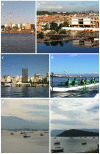Environmental and Sanitary Conditions of Guanabara Bay, Rio de Janeiro
- PMID: 26635734
- PMCID: PMC4653747
- DOI: 10.3389/fmicb.2015.01232
Environmental and Sanitary Conditions of Guanabara Bay, Rio de Janeiro
Abstract
Guanabara Bay is the second largest bay in the coast of Brazil, with an area of 384 km(2). In its surroundings live circa 16 million inhabitants, out of which 6 million live in Rio de Janeiro city, one of the largest cities of the country, and the host of the 2016 Olympic Games. Anthropogenic interference in Guanabara Bay area started early in the XVI century, but environmental impacts escalated from 1930, when this region underwent an industrialization process. Herein we present an overview of the current environmental and sanitary conditions of Guanabara Bay, a consequence of all these decades of impacts. We will focus on microbial communities, how they may affect higher trophic levels of the aquatic community and also human health. The anthropogenic impacts in the bay are flagged by heavy eutrophication and by the emergence of pathogenic microorganisms that are either carried by domestic and/or hospital waste (e.g., virus, KPC-producing bacteria, and fecal coliforms), or that proliferate in such conditions (e.g., vibrios). Antibiotic resistance genes are commonly found in metagenomes of Guanabara Bay planktonic microorganisms. Furthermore, eutrophication results in recurrent algal blooms, with signs of a shift toward flagellated, mixotrophic groups, including several potentially harmful species. A recent large-scale fish kill episode, and a long trend decrease in fish stocks also reflects the bay's degraded water quality. Although pollution of Guanabara Bay is not a recent problem, the hosting of the 2016 Olympic Games propelled the government to launch a series of plans to restore the bay's water quality. If all plans are fully implemented, the restoration of Guanabara Bay and its shores may be one of the best legacies of the Olympic Games in Rio de Janeiro.
Keywords: Guanabara Bay; anthropogenic impacts; bacteria; microalgae; pollution; sanitary conditions.
Figures






References
-
- Amador E. (1997). Baía de Guanabara e Ecossistemas Periféricos: Homem e Natureza. Rio de Janeiro: Retroarte Gráfica e Editora, 539.
-
- Amador E. S. (1980). Assoreamento da Baía de Guanabara - taxas de sedimentação. An. Acad. Bras. Cienc. 52 723–742.
-
- Anderson D. A., Glibert P. M., Burkholder J. M. (2002). Harmful algal blooms and eutrophication: nutrient sources, composition, and consequences. Estuaries 25 704–726. 10.1007/BF02804901 - DOI
Publication types
LinkOut - more resources
Full Text Sources
Other Literature Sources

